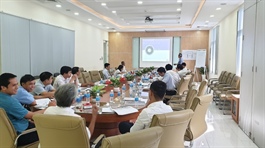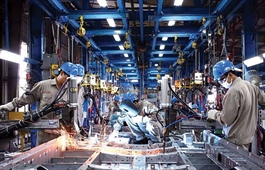Why Vietnamese brands struggle in other markets
Why Vietnamese brands struggle in other markets
Trade protection and brand building have become an imperative for product distinction of local businesses in overseas markets. Wolfgang Friess and Trung Trinh Hien from Austrian-backed company Live Forever Young, based in Hanoi, look into the current situation and the causes behind it, as well as suggest the way forward for true brands to make a mark in the global market.

Wolfgang Friess (left) and Trung Trinh Hien from Austrian-backed company Live Forever Young
|
Did you ever wonder why Vietnam is a successful exporting country of so many products, but no Vietnamese brand stands out overseas? From textiles, footwear, and furniture to coffee, pepper, exotic fruits, and fish, Vietnam ships a lot of products to Europe, the Americans, and many other countries in the world. Yet, there is not even one reputable Vietnamese brand?
Sometimes corporations announce that they have sales in the United States, Czech Republic, or in Germany. They are right: they have sold something to the Czechs, they may even have passively sold their brand, and some consumers may find it in some unpopular stores.
But through this brand value is not built. On the contrary; brand value is damaged for the long run and the brand is stuck without any professional positioning study. That brand risks being stuck in that poor position for decades and only reaching fewer than 5 per cent of its potential consumer base.
Meanwhile, companies from nations all over the world use that time to build their brand and widen the winning gap.
Just think about all the brand cosmetics from Japan or South Korea; think about all the nutrition supplements from Australia, and the US; think about the kitchen equipment from Germany; and think about the luxury bags or home furniture from Italy or France. Have in mind the price-point of such a French luxury bag versus a local or regional bag and see the “value creation”.
Even though trading and producing for others as an original equipment manufacturer (OEM) brings in important revenue for corporations and tax collectors, it only produces low value sales. Companies and the state miss out on high-value branded sales of final premium products as it happens the other way round: overseas companies bring in high-value brands into Vietnam.
Vietnamese businessmen are strong and successful in manufacturing and trading like in the case of peppers or cashews; and companies make good revenues in OEM and passive-selling, but that’s it. Some Vietnamese companies do a great job in brand-building locally and have built strong brands inside Vietnam, but why do we fail across the borders?
Vietnamese companies and the mindset of local executive directors master perfectly the left side of the scale and this brings in important revenues for the state in tax collection and companies paying corporate taxes. OEM and passive selling of a brand both have reason for existence for its benefits, and it is a workable model.
Succeeding on the left scale and failing on the right scale is a combination of several factors: lack of financial resources, hurdles in overseas capital investments, shortcomings in competencies and capabilities of teams, and the mindset of executive directors or shareholders to focus on short-term profits.
Live Forever Young (LFY) has worked for several Vietnamese companies to bring them into the US or EU. It only focuses on Europe and the US with a team of expert associates in both regions.
Whilst working for many strong companies of local success, LFY experts from Vietnam, Europe, and the US can clearly see the shortcomings for Vietnam to enter the race of creating brand value overseas, and of cashing in from the beautiful things that Vietnamese businessmen have to offer.
The day will come that Vietnamese companies learn the rules of success of brand-building in the US or EU, though this day is still far away. If that day comes revenues will double or triple, and subsequently cash will come into the state coffers.
Most OEMs that made their first steps in passive selling got used to some benefits, which are not there when carrying out brand-building or “selling with owned overseas marketing investment”. These benefits are receiving cash against documents; no need to send any money overseas for paying marketing activities; and avoiding the hurdles of overseas banking systems.
If a company invests in brand-building, this Vietnamese company would own the goods still in a warehouse in, for example, Austria or California. Payment terms usually delay the reception of payment after the final retailer has received the branded goods.
On top of this, the manufacturer or brand-owner needs to pay, upfront, marketing agencies or merchandising teams for their work. Very often the brand owner will have expenses with the retailers even before the first revenues. In the US, retailers may ask for a slotting fee, in Europe the retailer may ask for a listing fee. These upfront investments are so painful to the Vietnamese businesses’ mindset, but they are common practice and a rule to succeed in the US market.
The overseas banking system is so scary to Vietnamese companies that while some take the effort and time, many others do not want to waste their time and energy.
Another element is the capabilities and the mindset of people, which can be explained in a short example. LFY got a Vietnamese brand into 170 stores in New Jersey and another 160 stores in New York with all the needed infrastructure and all required marketing and sale materials. That is the starting point of the difficulty: many people are not trained or never had the learned experience of setting up and managing all that infrastructure in the US, starting with the logistics and documents, leading into selecting and managing a warehouse. The invoicing, consumer handling, and much more infrastructure needs to be ready.
Besides that, retailers will only list you if you commit to them with a marketing and sales plan. Without marketing, the 170 stores in New Jersey cannot reach the expected velocity and kick your product out of the store 4-6 weeks later and request you to take back the stocks from their shelves. Don’t expect this brand to see that buyer a second time.
To many people brand building is designing a logo with some icons and then registering it as a trademark – that’s wrong, as anybody on the street can do that. Designing a logo and paying the registration fee can be done by any person, but building a brand is much more. Many people think brand building is marketing. Again, that is wrong. Marketing can support brand building, but building a brand is more than running a campaign.
These are examples and real experiences that let us understand why at the beginning we said it would still take many years before a Vietnamese company succeeds in brand building.
We hope to see that distant future day. To make it happen we are here to support companies in the US or EU. If you are really and truly serious, we know how to get you into the EU or US, but we only do brand-building. We may support you on “selling with owned marketing investment”, which means you are in charge of marketing and brand building.
Together we own the marketing programmes and we decide how to communicate for the brand. If you want the distributor to own it, then don’t work with us. You are just selling, but not creating a brand.


























